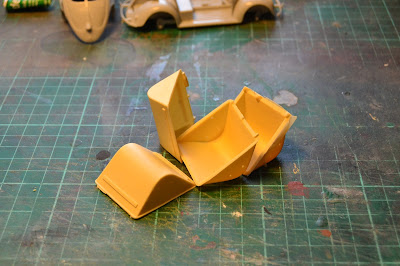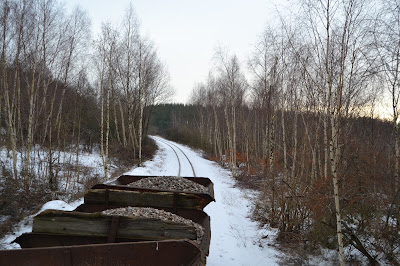No. Nystrup Gravel is not about to change scale or gauge - or even worse go standard gauge. Recent test running of locomotives on the
steel sleepered track on the factory module showed that the track laid down was a little under gauge. While narrow gauge is great, you can actually have too much 'narrowness'. A track gauge of 16.0 - 16.2 mm. is obviously too narrow to safely operate several of my locos. I also noted that my Magic Train steam loco bumped the bolts on the sleepers. I have consequently lifted my Coldicott-track.
Having mentioned my troubles on the
NGRM-forum a good friend from the Netherlands came to the rescue with track panels of his own design. Just at few days later I had a generous number of 3D printed steel sleepers on Code 83 rail to install.
 |
| The old track ripped up and new track panels being laid. The brick wall is still very far from finished and removable - which makes track laying easier. |
 |
| I am using track spikes from KBscale. The small spirit level is perfect for checking if the track is level. The light yellow resin sleepers are Blitz French army sleepers. They fit Code 100 rail. |
I laid the new track panels in the same way as I had laid the Coldicott panels. I inserted wooden sleepers under the rail ends and connected the rails by soldering them on
brass plates. In real life the wooden sleepers would provide stability to the track. Current to the rails is supplied by wires soldered to the underside of the rails connecting to heavier wires under the base board.
I used up my remaining few
Blitz
resin French army sleepers in one end of the module. I hadn't many left and I thought it fun to include an other type of steel sleeper on the module.
 |
| Shims of plastic of differing thickness are used to 'tamp' the track. 1:35 scale track building isn't that far from putting together full size track panels! The dummy fish plates are from KBscale. |
 |
| Testing the track with different vehicles help me determine if there are problematic spots in the track. Here the little speeder is being run back and forth on the module. The Q-tips are used for rail and wheel cleaning. |
 |
| The Fowler also ventured out on the track panels. My foam board factory building has been exchanged with a laser cut MDF structure. More on that later. |
I'll probably keep testing the track a little longer before I start to paint and weather rails and sleepers. New parts for the bakelite factory arrived last week and I have been planning how to equip it with lights and a partial interior.



















